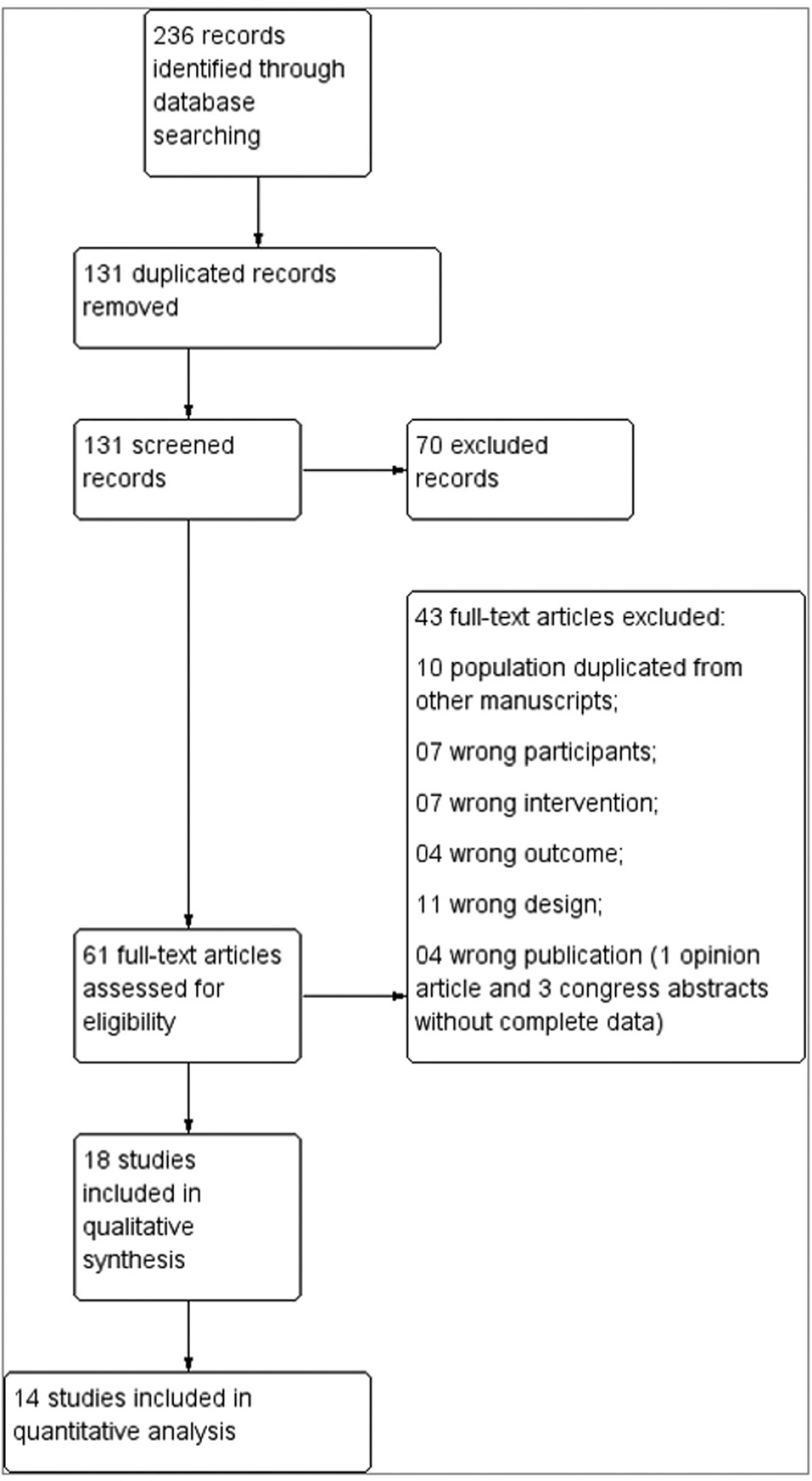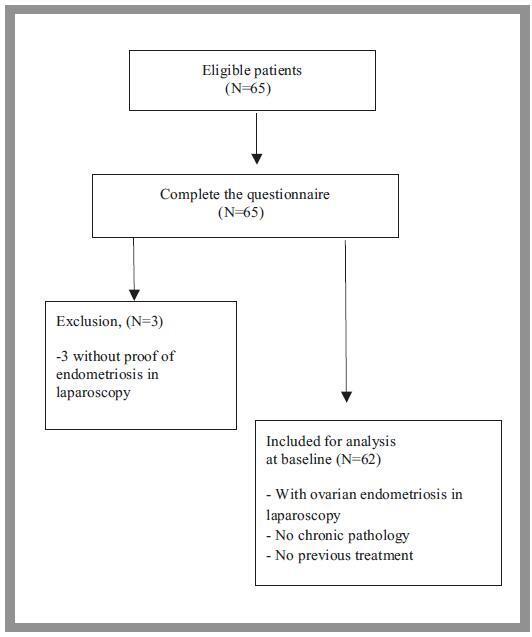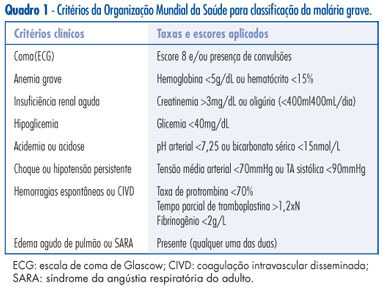You searched for:"Reginaldo Guedes Coelho Lopes"
We found (12) results for your search.Summary
Rev Bras Ginecol Obstet. 2023;45(8):489-498
To perform a systematic review and meta-analysis of studies on maternal, fetal, and neonatal outcomes of women with singleton pregnancies, after spontaneous conception, and with the diagnosis of amniotic sludge before 37 weeks of gestational age.
We conducted a search on the PubMed, Cochrane, Bireme, and Theses databases until June 2022.
Using the keywords intra-amniotic sludge or fluid sludge or echogenic particles, we found 263 articles, 132 of which were duplicates, and 70 were discarded because they did not meet the inclusion criteria.
The articles retrieved were analyzed by 2 reviewers; 61 were selected for full-text analysis, 18 were included for a qualitative analysis, and 14, for a quantitative analysis.
Among the maternal outcomes analyzed, there was an increased risk of preterm labor (95% confidence interval [95%CI]: 1.45–2.03), premature rupture of ovular membranes (95%CI: 1.99–3.79), and clinical (95%CI: 1.41–6.19) and histological chorioamnionitis (95%CI: 1.75–3.12). Regarding the fetal outcomes, there was a significant increase in the risk of morbidity (95%CI: 1.80–3.17), mortality (95%CI: 1.14–18.57), admission to the Neonatal Intensive Care Unit (NICU; 95%CI: 1.17–1.95), and neonatal sepsis (95%CI: 2.29–7.55).
The results of the present study indicate that the presence of amniotic sludge is a risk marker for preterm delivery. Despite the heterogeneity of the studies analyzed, even in patients with other risk factors for prematurity, such as short cervix and previous preterm delivery, the presence of amniotic sludge increases the risk of premature labor. Moreover, antibiotic therapy seems to be a treatment for amniotic sludge, and it may prolong pregnancy.

Summary
Rev Bras Ginecol Obstet. 2019;41(9):548-554
To evaluate the existence of an association between ultrasound findings and epidemiological and clinical factors using results obtained from the EHP-30 questionnaire in women with ovarian endometriosis.
A cross-sectional observational study was performed between July 2012 and May 2015, in which patients with chronic pelvic pain suggestive of endometrioma, as indicated by the results from a transvaginal pelvic ultrasonography, completed the standardized Endometriosis Health Profile - 30 (EHP-30) questionnaire to access quality-of-life scores before beginning treatment for endometriosis. A total of 65 patients were included. The data was analyzed in the statistical program IBM SPSS Statistics for Windows, Version 22.0 (IBM Corp., Armonk, NY, USA) for the comparison of data through linear multiple regression.
The suitability of the linear regression model was confirmed by the histogram of the dependent variable and the residue distribution plot, confirming the trend of linearity as well as the homogeneous dispersion of the residues. The mean age of the patients was 39.7 ± 7.1 years old. Themajority was Caucasian (64.5%), had completed higher education (56.5%) and was nulligravida (40.3%). Infertility was present in 48.4% of the patients studied. Out of the total sample, 80.6% of the cases were symptomatic and complained mainly of acyclic pain, 79% of dysmenorrhea, and 61.3% of dyspareunia. This reflects the negative influence of endometriosis on the quality of life of patients with this disease.
Dyspareunia and acyclic pain were independent factors of correlation with high scores in the EHP-30 questionnaire, reflecting a worse quality of life.

Summary
Rev Bras Ginecol Obstet. 2010;32(12):579-583
DOI 10.1590/S0100-72032010001200003
PURPOSE: to analyze the clinical course of three pregnant patients with severe malaria admitted to the intensive care unit of a hospital in Porto Velho (RO), Brazil. METHODS: a descriptive study was conducted on three pregnant women infected with Plasmodium falciparum malaria, admitted to the intensive care unit of a hospital in Porto Velho from 2005 to 2006. Categorical variables used were the classification criteria of the World Health Organization which ranks severe malaria and the Acute Physiology and Chronic Health Disease Classification System II (APACHE II) and Sepsis Related Organ Failure Assessment (SOFA) predictors of morbidity and severity of intensive care unit diseases. RESULTS: the malaria acquired by the pregnant subjects characterized by infection with Plasmodium falciparum in its most serious form resulted in death for all three patients and their fetuses. CONCLUSIONS: although the sample of this study was small it reflects the important impact of severe malaria on pregnant women as well as the need for a more judicious and attentive prenatal care to identify the disease in its early stages and its first complications in pregnant women.

Summary
Rev Bras Ginecol Obstet. 2012;34(2):80-85
DOI 10.1590/S0100-72032012000200007
PURPOSE: To evaluate the clinical outcomes after a minimum period of 5 years of follow-up of patients with abnormal uterine bleeding of benign etiology who underwent endometrial ablation, analyzing the success rate of treatment defined as patient satisfaction and improvement in uterine abnormal bleeding, as well as late complications and factors associated with recurrence of symptoms. METHODS: A cross-sectional survey was conducted after a minimum period of 5 years after surgery in patients who underwent the procedure between 1999 and 2004. We analyzed the following data: age at the time of surgery, immediate and late complications and associated factors. Logistic regression with Odds Ratio (OR) calculation was performed to evaluate possible associations between the success rate of surgery and the analyzed variables. RESULTS: A total of 114 patients underwent endometrial ablation between March 1999 and April 2004. The median follow-up was 82 months. The logistic regression model allowed the correct prediction of the success of endometrial ablation in 80.6% of cases. Age was directly related to the success of the procedure (OR=1.2; p=0.003) and previous tubal ligation showed a negative association with the success of endometrial ablation (OR=0.3; p=0.049). Among the patients with treatment failure, 21 (72.4%) underwent hysterectomy. In one of the hysterectomy cases, hydro/hematosalpinx was confirmed by the anatomopathological exam, characterizing the postablation-tubal sterilization syndrome. CONCLUSION: Endometrial ablation has proven to be a worthwhile treatment option, maintaining high rates of patient satisfaction, even over long-term follow-up. The age at endometrial ablation influenced the therapeutic success. Further studies are needed to evaluate the factors that may influence the future indication for the procedure in selected cases.